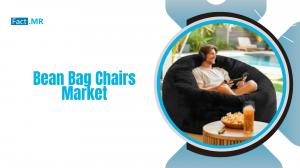Global Bean Bag Chairs Market to Reach USD 2.3 Billion by 2035 According to Fact.MR
Bean Bag Chairs Market Analysis By Raw Material (Cotton, Leather, Faux Leather, Polypropylene and Others), By Application, By Distribution Channel and By Region
MD, UNITED STATES, June 2, 2025 /EINPresswire.com/ -- The global bean bag chairs market is expected to reach USD 1.5 billion in 2025. The industry will achieve a CAGR of 4.7% and reach USD 2.3 billion by 2035, driven by the increase in demand for affordable, flexible, and ergonomic seating solutions across young consumers as well as households in urban cities that are interested in casual, customized furniture.The growth accounts for a consumer preference toward casual, ergonomic, and value-for-money seating arrangements encouraged by urbanization, interior design trends, and lifestyle changes. Young shoppers, remote workers, and design-conscious consumers are influencing demand for plush seats supporting compact living circumstances. Faux leather, cotton, and recycled materials dominate the list of material choices, both satisfying the senses and being practical.Customization and sustainability are emerging as determinant drivers, with consumers looking for eco-certified, hypoallergenic, and convertible setups. Embedding technology in materials—spill-proof smart fabrics—and expansion in modular bean bag systems are shaping upcoming trends. As products become easily accessible through e-commerce and influencer marketing amplifies awareness, brands are growing at a tremendous pace through residential and commercial spaces. With seating now becoming a statement of style and comfort, bean bag chairs are shifting from novelties to interior staples.
For More Insights into the Market, Request a Sample of this Report:https://www.factmr.com/connectus/sample?flag=S&rep_id=10734
Growth Drivers Fueling Market Expansion
Demand for bean bag chairs is driven by shifting lifestyle needs in city residences and remote work setups. Compact, relaxed furniture that contributes to minimalistic interiors is gaining traction among millennials and Gen Z generations. Cotton and faux leather bean bags offer design versatility and functionality that are appropriate for modern living.
Sustainability is the driving force for growth. Firms are turning toward biodegradable filling, recycled material, and animal-free alternative leathers to meet the growing demand for ethical home furnishings. Technology also lends appeal—smart materials, modular design, and transformable formats bring technology and function into comfort-driven furniture.
Regional Insights
North America leads the market with demand for eco-friendly, stylish indoor-outdoor bean bags. Europe follows with an emphasis on green materials and premium design. Asia Pacific is expanding rapidly as disposable incomes rise and casual furniture becomes mainstream. China and South Korea are driving product innovation, whereas Japan and Australia-New Zealand favor quality, simplicity, and wellness-driven purchasing.
Key Takeaways from the Market Study
Bean bag chairs market to reach USD 2.3 billion by 2035.
CAGR projected at 4.7% from 2025 to 2035.
Faux leather leads raw material shares at 37.5% in 2025.
Residential sector dominates with 61.5% share in 2025.
China grows fastest at 7.2% CAGR.
U.S. bean bag chairs market expands at 6.5% CAGR.
Survey Insights and Stakeholder Priorities
Fact.MR analysis found that 77% of stakeholders prioritize sustainability, with a shift toward recyclable, biodegradable, and organic materials. About 71% emphasize customization in color, fit, and texture, particularly targeting Gen Z and millennial buyers. Another 68% stress durability as consumers demand longer product lifecycles.
Regional strategies differ: North America focuses on indoor-outdoor hybrids, Europe leads with eco-certifications, and Asia Pacific emphasizes value-for-money with scalable design. While 61% invest in smart fabrics and 58% apply AI for customer personalization, 70% still cite challenges in raw material pricing and logistics. Long-term growth will rely on greener supply chains, modular designs, and automation in production.
Get Customization on this Report for Specific Research Solutions-https://www.factmr.com/connectus/sample?flag=S&rep_id=10734
Companies Targeting
LoveSac leads the category with its modular, eco-conscious Sactionals and premium foam-based bean bags. Fatboy differentiates with stylish, oversized offerings for indoor-outdoor use, appealing to hospitality and residential clients. Yogibo focuses on sensory wellness and ergonomic comfort, gaining traction in therapeutic and wellness spaces across Asia.
Sumo Lounge and Comfy Sacks dominate the gaming and home theater segments with customizable, oversized loungers. Meanwhile, Big Joe, MUJI, and Ace Bayou address budget-conscious buyers through retail chains and online platforms. CordaRoy's continues to gain visibility with bed-convertible designs, leveraging D2C channels and media promotions to drive awareness and growth.
Segmental Insights
Faux leather will capture 37.5% of the market in 2025, favored for its cleanability and upscale aesthetic. Popular with families and commercial users, it’s also endorsed by sustainability-conscious consumers as a leather alternative.
Cotton follows with 26.5% share, preferred for its breathable comfort and suitability for sensitive users. Brands like Chill Sack and CordaRoy’s promote cotton-based bean bags for their softness and affordability, especially in tropical climates and casual settings.
Key Companies Profiled-
LoveSac | Fatboy | Yogibo | Sumo Lounge | Comfy Sacks | Ultimate Sack | CordaRoy’s | Big Joe | MUJI | Ace Bayou Corp
Explore More Related Studies Published by Fact.MR Research:
The global smart pet feeder market experienced year-on-year (YoY) growth of 5.2% in 2021 to reach a market valuation of US$ 187.3 million. Worldwide sales of smart pet feeders are expected to surge at 7.8% CAGR to reach US$ 419.2 million by the end of 2032.
The global vacuum dust filter market was valued at US$ 1,609.7 million by 2024 end and has been estimated to expand at a noteworthy CAGR of 5.9% to end up at US$ 2,855.6 million by 2034. Mining type under end user type of segment will be worth around US$ 325.2 million in 2024 and account for a 20.2% global market share.
Contact:
11140 Rockville Pike
Suite 400
Rockville, MD 20852
United States
Tel: +1 (628) 251-1583
Sales Team: sales@factmr.com
Follow Us: LinkedIn | Twitter | Blog
S. N. Jha
Fact.MR
+1 628-251-1583
email us here
Legal Disclaimer:
EIN Presswire provides this news content "as is" without warranty of any kind. We do not accept any responsibility or liability for the accuracy, content, images, videos, licenses, completeness, legality, or reliability of the information contained in this article. If you have any complaints or copyright issues related to this article, kindly contact the author above.
Warehouse Robotics Market to Reach $31,343.7 Million by 2032 at 18.2% CAGR: Allied Market Research
Nano Gold in India Market Growth Analysis Report with Future Business Scope and New Investment Plans by 2027
Packaging and Protective Packaging Market to Reach USD 1.5 Billion by 2031, Expanding at a Steady CAGR of 4.3%
Kalendarium
Więcej ważnych informacji
 Jedynka Newserii
Jedynka Newserii

 Jedynka Newserii
Jedynka Newserii

Prawo

KE proponuje nowy Fundusz Konkurencyjności. Ma pobudzić inwestycje w strategiczne dla Europy technologie
W środę 16 lipca Komisja Europejska przedstawiła projekt budżetu na lata 2028–2034. Jedna z propozycji zakłada utworzenie Europejskiego Funduszu Konkurencyjności o wartości ponad 400 mld euro, który ma pobudzić inwestycje w technologie strategiczne dla jednolitego rynku. Wśród wspieranych obszarów znalazła się obronność i przestrzeń kosmiczna. Na ten cel ma trafić ponad 130 mld euro, pięciokrotnie więcej niż do tej pory.
Firma
Były prezes PGE: OZE potrzebuje wsparcia magazynów energii. To temat traktowany po macoszemu

Choć udział odnawialnych źródeł energii w miksie energetycznym Polski jest stosunkowo wysoki i rośnie, to ten przyrost jest chaotyczny i nierównomiernie rozłożony miedzy technologiami – wskazuje Forum Energii. Dodatkowo OZE potrzebują wsparcia magazynów energii, a zdaniem Wojciecha Dąbrowskiego, prezesa Fundacji SET, ten temat jest traktowany po macoszemu. Brak magazynów powoduje, że produkcja energii z OZE jest tymczasowo wyłączana, co oznacza marnowanie potencjału tych źródeł.
Infrastruktura
Wzrost wynagrodzeń ekip budowlanych najmocniej wpływa na koszty budowy domu. Zainteresowanie inwestorów mimo to nieznacznie wzrasta

Budowa metra kwadratowego domu w Polsce kosztuje od 5,55 do 6 tys. zł w zależności od województwa – wynika z najnowszych analiz firmy Sekocenbud. Najdrożej jest w Warszawie, gdzie cena za metr kwadratowy domu przekroczyła już 6,2 tys. zł. Na przyrosty kosztów budowy domu wpływają zarówno drożejące materiały budowlane, jak i wyższe wynagrodzenia pracowników. Inwestorzy nie rezygnują jednak z budowy domów jednorodzinnych, co ma związek m.in. z wciąż wysokimi cenami mieszkań czy też obniżką stóp procentowych.
Partner serwisu
Szkolenia

Akademia Newserii
Akademia Newserii to projekt, w ramach którego najlepsi polscy dziennikarze biznesowi, giełdowi oraz lifestylowi, a także szkoleniowcy z wieloletnim doświadczeniem dzielą się swoją wiedzą nt. pracy z mediami.









.gif)

 |
| |
| |
|